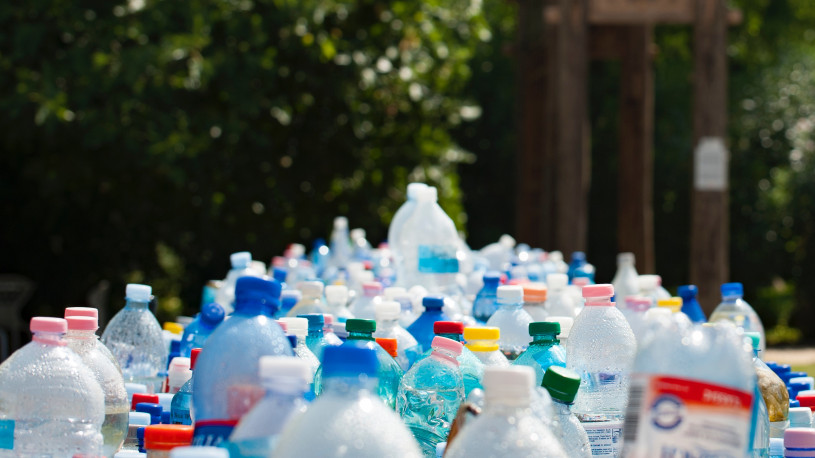-
Are we Witnessing the Dawn of a Bio-Plastics Revolution?
 Continue Reading
Continue ReadingPlastics manufacturers, polymer traders and industry specialists are beginning to sense that the plastics industry is on the brink of a new era. Ever since Bakolite, (or polyoxybenzylmethylenglycolanhydride, as a polymer chemist might call it), was invented in 1907 the plastics industry has seen growth. The number of uses for plastic has expanded almost exponentially such that today’s world is filled with the stuff.
But nowadays, there exists a business climate where ‘sustainable’ is not just a buzz word but a political and economic goal. This is leading many plastic producers, traders and most importantly end-users to head away from fossil fuel-based polymers to an age of bio-plastics. Evidence of this sea change can be seen in the actions of world’s leading companies.
Take for example Lego, the toy brick firm, who from being almost bankrupt in 2003, is now the world’s second largest toy manufacturer (behind Mattel). Not only has the company been able to turn around its business fortunes, they have also been active in lowering the impact their business has on the environment.
Amazingly, Lego bricks have changed little since they were first invented in 1945, as the original few bricks are, as Fast Company reports, “compatible with all the billions of bricks that have followed.” This is because, “Except for a material swap in 1963 to the shiny, hard ABS plastic still used today, the basic bricks have never changed.”
But now that the company is on the route of a third phase of ‘organic growth’, it is taking the time to look at its environmental impact. As a result, the company has begun research into replacing the oil based plastics with bio-plastics.
As Lego spokesperson Kathrine Bisgaard Vase told the online journal Environmental Leader, “Lego bricks are made from the highest quality plastics, which is very functional and durable as a material. However, the current raw materials we use for manufacturing Lego bricks are oil-based, and that is a scarce resource. So we are searching for a new material that is not based on oil.”
While recycled or reclaimed plastic may have been a cheaper option for Lego, the specifics of the bricks and the toy market has ruled this out. As Jennie Lynch, associate at the independent research company, Lux Research, explained, “Challenges associated with identifying the source of recycled materials, as well as concerns about the reuse of hazardous resins such as PVC, could present contamination issues for Lego. In addition, the quality of recycled plastic resin degrades every time it is reused, meaning this is unlikely to meet the durability requirements set by the company for its products.”
But Lego is not alone in looking to use sustainable plastics, as last year IKEA signed an agreement that will see as much as 40% of the plastic in its furniture made from renewable resources.
The cooperating company is the US based firm Newlight, who have created a material which, the journal Biobased World reports, “uses the process of converting air and greenhouse gas into biodegradable plastics, which are proven to out-compete oil-based plastics on price and performance.”
They have achieved this by developing a “biotechnological process to produce their AirCarbon material: a family of high-performance polyhydroxyalkanoate (PHA)-based thermoplastic materials made from carbon emissions.” Which has a “so called ‘secret sauce’ that is a biocatalyst that combines composites of air and methane, and reassembles the carbon, hydrogen and oxygen molecules into a thermoplastic.”
You can learn more about this process on the YouTube video here.
But when it comes to leading companies, the most globally recognised brand in the world is also showing the way when it comes to replacing oil-based plastics. This is because Coca-Cola has developed a bio-plastic bottle.
As Bioplastics Magazine reported, “On June 3rd, 2015 The Coca-Cola Company unveiled the world’s first PET plastic bottle made entirely from plant materials at the World Expo – Milan. PlantBottle™ packaging pushes the boundaries on sustainable innovation by using groundbreaking technology to create a fully recyclable plastic bottle made from renewable plant materials.”
As Nancy Quan, Global Research and Development Officer, The Coca-Cola Company, said, “Our vision was to maximize game-changing technology, using responsibly sourced plant-based materials to create the globe’s first fully recyclable PET plastic bottle made entirely from renewable materials.”
And it is this vision, not from environmental protection groups, not from politicians, not even from the public, but from the heads of industry that will drive the expansion of bio-plastics. Moreover, as companies like Lego, IKEA and Coca-Cola make clear to others that a change is not only possible, but practical (given the removal of fluctuating oil prices and the marketing benefits of a greener product) then it becomes increasingly likely that the flood gates will open on a bio-plastics revolution.
Bio-plastics will no longer be seen as a way to save the planet or improve brand image, but as a natural step in the development of an industry. Much as telecommunications has changed with the development of mobile phone technology, or the construction industry changed with the advent of reinforced concrete, so too will the plastics industry change.
Plastics manufacturers and traders must simply ask themselves where they will be when the alarm clock rings on the dawn of the bio-plastics revolution.
-
A Better Way to Recycle Waste Plastic into Fuel
 Continue Reading
Continue ReadingChemists from the University of California and the Chinese Academy of Sciences have discovered a new chemical process that may save the plastics industry, and might even save the planet. This is because they have found a method for turning plastic (PE) into a fuel that degrades plastic in a ‘milder and more efficient manner’.
Current processes for converting plastic into fuel often use ‘caustic chemicals known as radicals or heating the material to more than 400°C to break down the chemical bonds of the polymers’. However the latest discovery uses a process called ‘cross-alkane metathesis’, which employs chemicals that are readily available by-products from refining and operates at temperatures of only 175°C. This means that mankind may finally be on the brink of industrial scale conversion of plastic waste into fuel. A breakthrough that may lead to cleaner beaches and oceans, improve profit margins for plastics manufacturers and may even lead businesses to mining landfill sites for waste plastic feedstock.
As the research team states in their study, published in the journal Science Advances, “Alkane metathesis is a process in which alkanes are covalently rearranged to give a new distribution of alkane products. Because PE is essentially composed of ultra-long alkanes, we envisioned that alkane metathesis could be used to cleave PE chains. [In this study] we report a mild and efficient degradation of PE into liquid fuels and waxes using inexpensive and readily available light alkanes, such as petroleum ether, as the reagents. These alkanes with low carbon number are major constituents of a variety of refinery and petrochemical streams, the Fischer-Tropsch process, and some biomass conversion pathways. We show that the cross metathesis between these low-value light alkanes and PE results in very efficient degradation of various grades of PE. In particular, we demonstrate that the wastes of commercial PE plastics can be selectively degraded into transportation fuels and waxes under mild conditions in a controllable manner.”
The online journal Phys.org described the process as follows; “The method by the team involves mixing the plastics with an organometallic catalyst, which was made by mixing readily available molecules that were then doped with metal iridium. The reaction caused the bonds holding the plastic together to weaken, allowing them to be more easily torn apart—after doing, so, the team was able to use the broken down material to create a diesel-like fuel which they claim could be used to power vehicles and other motors—they report that burning the fuel is also cleaner than burning other combustible materials.”
However, the team is continuing its study as the process has yet to reach a level of efficiency whereby industrial conversion of plastic to fuel would be financially viable. At present the catalyst in use is recyclable, but with diminished effectiveness. Furthermore, as Phys.org reports, “The ratio of plastic to catalyst is currently approximately 30 to1, which is not nearly good enough for commercial purposes. Their goal is 10,000 to 1. The team is also looking for something to use as part of the catalyst instead of iridium, because it is both difficult to get in large quantities and too expensive.”
Evidently there is still much work to do before cleaning up the plastic from our oceans, beaches and landfill sites becomes profitable, but it is possible that this discovery could be a major turning point in our relationship with plastic. Today, plastic is viewed by many as a single use, fossil fuel product that is nothing more than a necessary evil in the modern world. If the chemical industry were able to convert plastic products at the end of their life into a useable fuel, then the image of plastics manufacturers would be changed forever. Indeed, it may even lead to an enlightened view on what chemical engineering can achieve for the planet.
Photo credit: Jayme Navarro
-
A Coating that can Switch between Adhesion and Non-Adhesion
 Continue Reading
Continue ReadingFor many years the chemical industry has been able to make a material waterproof. Material designers have copied nature, such as the composition of a lotus leaf that prevents moisture getting in. Similarly, chemists have developed materials and coatings that produce high adhesion.
But until now, mankind has yet to create a practical material that can switch from ‘sticky’ to ‘slippery’ and back again. This is because previous research in this field has only led to the production of very fragile materials.
However, a new study has found a much more robust product that uses a layer of boron nitride and an electric current so that, as the online journal Phys.org reports, “… it can be switched back and forth between states with high and low wetting and adhesion.”
A material’s stiction (static friction) and wetting are usually dictated by the nanostructure of the surface and how it interacts with another surface, including the geometry of the atoms, but the relationship between these two states has often been little understood.
But now a breakthrough has been made, and the results published in the online journal Nature, which states that, “Stiction and adhesion can be reversibly switched by applying different electrochemical potentials to the sample [a hexagonal boron nitride monolayer on rhodium], causing atomic hydrogen to be intercalated or not.”
As one of the lead researchers, Thomas Greber from the Physics Institute at the University of Zürich, explained, “Just as the material graphene consists of only one layer of carbon atoms, our boron nitride has a thickness of only one atomic layer.”
The online journal Phys.org explained in more detail, stating that, “This ultrathin layer can be grown on a rhodium single crystal. The atoms on the rhodium surface and in the boron nitride form a hexagonal pattern, but the distances between the atoms in the two materials are different. Thirteen atoms in boron nitride take the same space as twelve rhodium atoms, so that the two crystals do not fit together perfectly. Because of this mismatch, the boron nitride hexagons must bend, they appear as a frozen wave with a wavelength of 3.2 nanometres and a height of about 0.1 nanometres.”
The ‘two-dimensional nanowave’ allows the surface to have low stiction when in contact with water. However, by putting the material in acid and applying an electrical current the surface changes. This is because, “… hydrogen atoms creep under the boron nitride layer and change the bond between nitrogen and rhodium. This makes the boron nitride flat. Suddenly the adhesion of a water drop on the surface changes dramatically – even though the drop is 100,000 times bigger than the tiny waves in the boron nitride. If the voltage is decreased, this effect is reversed.”
As a result, the materials ‘stickiness’ and ‘slipperiness’ can be freely switched back and forth.
A video clip of the experiment in progress can be seen here.
But the true discovery is in how robust this new material is, as fellow researcher Stijn Mertens of the Institute of Applied Physics at the Vienna University of Technology explained, “Our surface consists of only a single layer of atoms, is completely inorganic and does not change even if we heat it in vacuum to 1000°C. This means that this material could also be used for applications where organic molecules would long be destroyed, ranging from daily life to space travel.”
With this level of sturdiness and stability the range of uses will be wide. It is only to be seen how long it takes the chemical industry to develop the discovery further so that it can be brought to market. Whilst chemists analyse the results to confirm their validity, those of a more business way of thinking are considering what applications this discovery may have. And ultimately asking themselves; “Where would you apply a material that is reversible between the states of adhesion and non-adhesion?”
Photo credit: Michael Gasperl & John Stave
Photo credit: Marcella Iannuzzi, UZH & Ari Seitsonen, ENS Paris
